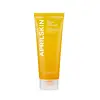What's inside
What's inside
 Key Ingredients
Key Ingredients

 Benefits
Benefits

 Concerns
Concerns

 Ingredients Side-by-side
Ingredients Side-by-side

Water
Skin ConditioningCalendula Officinalis Flower Water
MaskingSodium Lauroyl Sarcosinate
CleansingCocamidopropyl Betaine
CleansingGlycerin
HumectantSodium Lauroyl Glutamate
Lauramide DEA
Disodium Cocoamphodiacetate
CleansingPEG-120 Methyl Glucose Dioleate
EmulsifyingSodium Chloride
MaskingCitric Acid
BufferingButylene Glycol
HumectantPanthenol
Skin ConditioningBeta-Glucan
Skin ConditioningChamomilla Recutita Flower Extract
MaskingCentaurea Cyanus Flower Extract
AstringentBorago Officinalis Extract
EmollientLavandula Angustifolia Flower Extract
CleansingLavandula Angustifolia Flower/Leaf/Stem Extract
MaskingSalix Alba Bark Extract
AstringentCalendula Officinalis Flower
Skin ConditioningCalendula Officinalis Flower Extract
MaskingCitrus Aurantium Dulcis Peel Oil
MaskingSalicylic Acid
MaskingHexylene Glycol
Emulsifying1,2-Hexanediol
Skin ConditioningSodium Benzoate
MaskingWater, Calendula Officinalis Flower Water, Sodium Lauroyl Sarcosinate, Cocamidopropyl Betaine, Glycerin, Sodium Lauroyl Glutamate, Lauramide DEA, Disodium Cocoamphodiacetate, PEG-120 Methyl Glucose Dioleate, Sodium Chloride, Citric Acid, Butylene Glycol, Panthenol, Beta-Glucan, Chamomilla Recutita Flower Extract, Centaurea Cyanus Flower Extract, Borago Officinalis Extract, Lavandula Angustifolia Flower Extract, Lavandula Angustifolia Flower/Leaf/Stem Extract, Salix Alba Bark Extract, Calendula Officinalis Flower, Calendula Officinalis Flower Extract, Citrus Aurantium Dulcis Peel Oil, Salicylic Acid, Hexylene Glycol, 1,2-Hexanediol, Sodium Benzoate
Water
Skin ConditioningZinc Coceth Sulfate
CleansingLauryl Betaine
CleansingDecyl Glucoside
CleansingCeteareth-60 Myristyl Glycol
EmulsifyingPEG-7 Glyceryl Cocoate
EmulsifyingPolysorbate 20
EmulsifyingCitric Acid
BufferingParfum
MaskingCI 61570
Cosmetic ColorantIsopropyl Alcohol
SolventPEG-40 Hydrogenated Castor Oil
EmulsifyingPEG-6
HumectantPPG-26-Buteth-26
Skin ConditioningSilybum Marianum Fruit Extract
Skin ConditioningSodium Benzoate
MaskingSodium Chloride
MaskingSodium Hydroxide
BufferingTrisodium Ethylenediamine Disuccinate
CI 19140
Cosmetic ColorantZinc Gluconate
Skin ConditioningWater, Zinc Coceth Sulfate, Lauryl Betaine, Decyl Glucoside, Ceteareth-60 Myristyl Glycol, PEG-7 Glyceryl Cocoate, Polysorbate 20, Citric Acid, Parfum, CI 61570, Isopropyl Alcohol, PEG-40 Hydrogenated Castor Oil, PEG-6, PPG-26-Buteth-26, Silybum Marianum Fruit Extract, Sodium Benzoate, Sodium Chloride, Sodium Hydroxide, Trisodium Ethylenediamine Disuccinate, CI 19140, Zinc Gluconate
 Reviews
Reviews

Ingredients Explained
These ingredients are found in both products.
Ingredients higher up in an ingredient list are typically present in a larger amount.
Citric Acid is an alpha hydroxy acid (AHA) naturally found in citrus fruits like oranges, lemons, and limes.
Like other AHAs, citric acid can exfoliate skin by breaking down the bonds that hold dead skin cells together. This helps reveal smoother and brighter skin underneath.
However, this exfoliating effect only happens at high concentrations (20%) which can be hard to find in cosmetic products.
Due to this, citric acid is usually included in small amounts as a pH adjuster. This helps keep products slightly more acidic and compatible with skin's natural pH.
In skincare formulas, citric acid can:
While it can provide some skin benefits, research shows lactic acid and glycolic acid are generally more effective and less irritating exfoliants.
Most citric acid used in skincare today is made by fermenting sugars (usually from molasses). This synthetic version is identical to the natural citrus form but easier to stabilize and use in formulations.
Read more about some other popular AHA's here:
Learn more about Citric AcidSodium Benzoate is a preservative. It's used in both cosmetic and food products to inhibit the growth of mold and bacteria. It is typically produced synthetically.
Both the US FDA and EU Health Committee have approved the use of sodium benzoate. In the US, levels of 0.1% (of the total product) are allowed.
Sodium benzoate works as a preservative by inhibiting the growth of bacteria inside of cells. It prevents the cell from fermenting a type of sugar using an enzyme called phosphofructokinase.
It is the salt of benzoic acid. Foods containing sodium benzoate include soda, salad dressings, condiments, fruit juices, wines, and snack foods.
Studies for using ascorbic acid and sodium benzoate in cosmetics are lacking, especially in skincare routines with multiple steps.
We always recommend speaking with a professional, such as a dermatologist, if you have any concerns.
Learn more about Sodium BenzoateChances are, you eat sodium chloride every day. Sodium Chloride is also known as table salt.
This ingredient has many purposes in skincare: thickener, emulsifier, and exfoliator.
You'll most likely find this ingredient in cleansers where it is used to create a gel-like texture. As an emulsifier, it also prevents ingredients from separating.
There is much debate on whether this ingredient is comedogenic. The short answer - comedogenic ratings don't tell the whole story. Learn more about comegodenic ratings here.
The concensus about this ingredient causing acne seems to be divided. Research is needed to understand if this ingredient does cause acne.
Scrubs may use salt as the primary exfoliating ingredient.
Learn more about Sodium ChlorideWater. It's the most common cosmetic ingredient of all. You'll usually see it at the top of ingredient lists, meaning that it makes up the largest part of the product.
So why is it so popular? Water most often acts as a solvent - this means that it helps dissolve other ingredients into the formulation.
You'll also recognize water as that liquid we all need to stay alive. If you see this, drink a glass of water. Stay hydrated!
Learn more about Water